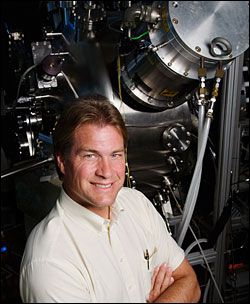
EUV Lithography Improved
Light has been generated and optics damage lessened in extreme ultraviolet lithography by adding a lighter gas to plasma. The microelectronics lithography method is considered a candidate for creating a new generation of smaller, more powerful computer chips.
In the quest for creating computer chips with ever-smaller feature sizes, manufacturers are exploring extreme ultraviolet (EUV) lithography as the next chip-printing technology. For a light source at the necessary wavelength, scientists have turned to a hot, ionized gas called a plasma, generated within a Z-pinch device. But, energetic ions produced in the plasma can damage the mirror responsible for collecting the light.
David Ruzic, a professor of nuclear, plasma and radiological engineering at the University of Illinois, and colleagues have discovered a technique that may help pack more power into smaller computer chips. (Photo: L. Brian Stauffer)
“By adding a lighter gas to the plasma, we can significantly reduce the damage and extend the lifetime of the collector optics,” said David Ruzic, a professor of nuclear, plasma and radiological engineering at the University of Illinois and lead author of a paper that described the technique in an issue of the journal IEEE Transactions on Plasma Science earlier this summer.
In a Z-pinch device, xenon is fed into a chamber where it collides with a stream of electrons, producing a low-temperature and low-density plasma. This plasma then flows between two cylindrical electrodes, one positioned inside the other. (The “Z” in Z-pinch refers to the direction of current flow along the cylindrical electrodes.)
Next, a large current pulse heats the plasma, while a magnetic field generated by the pulse compresses and confines the plasma. The plasma becomes hotter and denser until it “pinches,” creating the flash of light needed by the chip industry. As the pulse passes, internal plasma pressure overcomes magnetic confinement, and the hot, dense plasma flies apart. The resulting fast and energetic ions can damage the delicate collector optics.
However, adding a small amount of a lighter gas, such as hydrogen, “significantly reduces both the number and the energy of xenon ions reaching the collector surface, thereby extending the collector’s lifetime while having a negligible effect on the extreme ultraviolet light production,” Ruzic said.
The reduction in xenon energy occurs because the hydrogen ions shield the xenon ions from the high electric field created by the plasma.
“When the plasma flies apart, the less-massive electrons move faster than the hydrogen and xenon ions,” Ruzic said. “The electric field induced by the moving electrons then pulls on the ions and accelerates them. Being much lighter than xenon ions, the hydrogen ions accelerate faster, and shield the xenon ions from some of the electric field.”
By absorbing some of the plasma’s energy, the hydrogen ions prevent the xenon ions from accelerating to the point where they damage the collector surface, thus prolonging the collector’s lifetime.
Xenon is actually the second-best radiator for light at the desired wavelength, Ruzic said. “We can get three times as much light from tin, but tin is a condensable metal and makes quite a mess on the mirrors. We are now looking at ways to clean the mirrors during chip production.”
Ruzic’s coauthors are U of I graduate students Keith Thompson and Josh Spencer, postdoctoral research associate Shailendra Srivastava, and former postdoctoral researcher associates Brian Jurczyk and Erik Antonsen.
For more information, visit: www.uiuc.edu
Published: September 2007